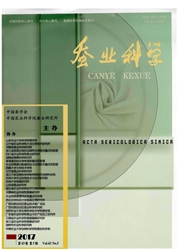

 中文摘要:
中文摘要:
用不同极性溶剂萃取桑叶粉中的活性物质,分别获得乙酸乙酯提取物、正丁醇提取物和水提取物。采用琼脂打孔扩散法评价桑叶各极性溶剂提取物的抑菌效果,结果表明桑叶不同极性溶剂提取物对供试革兰阳性菌和革兰阴性菌均有一定的抑制作用,其中乙酸乙酯提取物的抑菌活性显著高于其它溶剂提取物,对大肠杆菌(Escherichia coli)的最低抑菌浓度为6.3 mg/mL,对金黄色葡萄球菌(Staphyloccocus aureus)、枯草芽孢杆菌(Bacillus subtilis)、沙门氏菌(Salmonella sp.)的最低抑菌浓度均为12.5 mg/mL。测定乙酸乙酯提取物中的总多酚质量比为(11.91±0.67) mg/g,显著高于其它溶剂提取物,表明桑叶不同极性溶剂提取物的抑菌活性与其总多酚的含量成显著剂量效应关系(P<0.05)。
 英文摘要:
英文摘要:
Active substances were extracted from mulberry leaf powder using different polarity solvents. As a result, mulberry leaf ethyl acetate extract, butyl alcohol extract and water extract were obtained. The antibacterial effect of mulberry leaf extracts from different polarity solvents was evaluated with the agar punch diffusion method. The results showed that mulberry leaf extracts from different polarity solvents had certain inhibitory effect on both Gram-positive and Gram-negative bacteria for test. The antibacterial effect of ethyl acetate extract was significantly better than that of other extracts. Its minimum inhibitory concentration (MIC) to Escherichia coil was 6.3 mg/mL, and its MIC to all Staphyloccocus aureus, Bacillus subtilis and Salmonella sp. was 12.5 mg/mL. The total polyphenol content of ethyl acetate extract was (11.91 ±0. 67) mg/g, also significantly higher than that of other extracts, indicating that the antibacterial activity and the total polyphenol content of mulberry leaf extracts from different polarity solvents have a significant dose response relationship ( P〈0. 05).
 同期刊论文项目
同期刊论文项目
 同项目期刊论文
同项目期刊论文
 期刊信息
期刊信息
